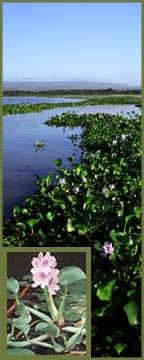Water Hyacinth
 Eichhornia crassipes [Martius] Solms
Eichhornia crassipes [Martius] Solms
Water Hyacinth is the most damaging aquatic weed in the world, believed to have been imported into the USA from South America as a water garden ornamental in 1884. Water Hyacinth is found globally in the tropics and subtropics, but its spread is limited by severe cold. In North America Water Hyacinth is mostly found in the southeastern United States. It is not yet present in Manitoba.
Description - Water hyacinth
General: Forms large free-floating mats that out-compete other aquatic plants for light, nutrients and oxygen. As much as 50% of biomass can be in the roots.
Leaves: Thick, waxy, rounded, and glossy. Leaves rise above water on stalks as high as 0.5 meters tall.Stem: Can grow to be 0.5 metres long, bulbous and spongy.
Flowers: A single flower spike per stem, with 8 to 15 flowers. Flowers are showy, purple to pink in colour and the uppermost petal has a yellow blue-bordered central splotch.
Seeds/Fruit: Thin walled capsule containing as many as 450 seeds.
Habitat
Water Hyacinth grows in ponds, wetlands, marshes, large lakes, reservoirs, and rivers. Plants can tolerate extreme environmental conditions including fluctuations in water levels, nutrient availability, acidity levels, temperature and levels of toxic substances.
Dispersal
Water Hyacinths spread mainly through vegetative reproduction, where a mother plant sends out underground stalks to grow daughter plants, which then mature and send out other daughter plants, and so on. To a lesser extent, the water hyacinth is also dispersed by seed, which can remain viable for 20 years or more after development. As well, with the increasing popularity of water gardening and home ponds, Water Hyacinth is sold by many nurseries for its exotic appearance and attractive flowers.
Impacts
Water Hyacinth invasions have a negative impact on aquatic habitats and general water use. They reduce available light and oxygen in the water, which alters the composition of invertebrate and fish communities and displaces native plants and wildlife. Infestations worsen mosquito problems and reduce water flow in drainage and irrigation canals as well as interfering with recreational and commercial water crafts. The economic costs of these invasions have been estimated into the millions of dollars.
Control Methods
Very small infestations can be controlled by hand pulling. Mechanized harvesting equipment is available but is very expensive to operate. Herbicide management has also been used but is costly and temporary, in addition to being harmful to other aquatic organisms. Floating barriers have been used to restrict the in lake spread of Water Hyacinth.
Biological control has included the use of insects, mites, fish and fungi, with some success. Biological control agents can slow the growth of Water Hyacinth and make the plants more susceptible to other causes of mortality.
Resources
Water Hyacinth — Project Fact Sheet
Â
Back to Aquatic Invasive Species List
Â

